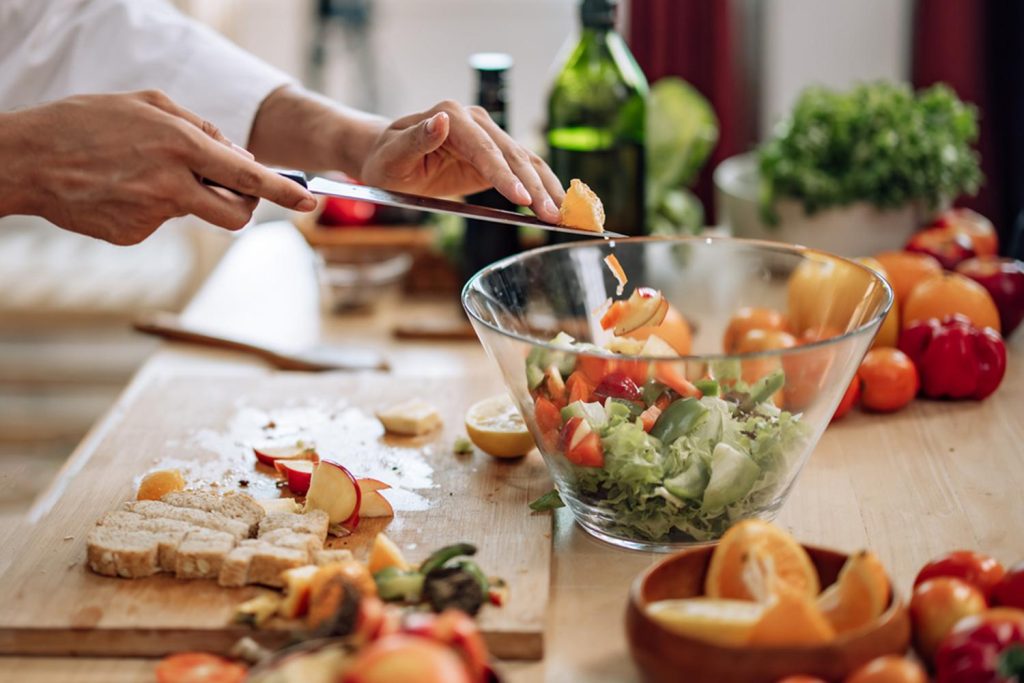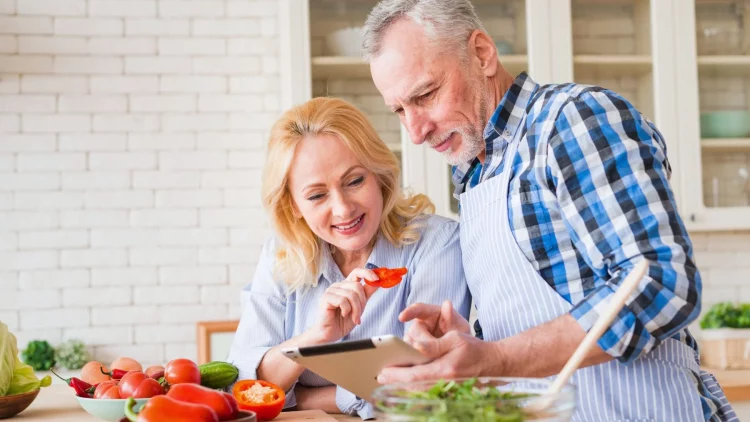In a world that values speed, efficiency, and convenience, cooking has often been reduced to a chore or even an afterthought. We grab takeout between meetings, reheat leftovers while answering emails, and rush through meals without fully tasting them. But what if the kitchen could be more than just a functional space? What if it could become a sanctuary—a place where we reconnect with our bodies, our minds, and the food that sustains us? Mindful cooking is about transforming the act of preparing food into a ritual of care, presence, and nourishment. It invites us to slow down, tune in, and approach the kitchen not just as a place to fuel our bodies, but as a space to restore our minds.
Redefining the Kitchen as a Mindful Space
The kitchen, for many, is simply the heart of the home—a room centered on tasks and practicality. But when we begin to view it through the lens of mindfulness, it takes on new meaning. It becomes a space for intention. Each motion, from chopping vegetables to stirring soup, becomes an opportunity to center ourselves. Instead of rushing through the process with a sense of urgency, we shift our mindset to one of gratitude, noticing the colors, textures, and aromas of the ingredients before us. In this way, the kitchen becomes not just a site of nourishment, but a refuge for mental clarity and inner peace.
The Science Behind Mindful Cooking
Emerging research supports what many have long known intuitively: engaging in routine, creative tasks like cooking can positively impact mental well-being. Cooking reduces cortisol levels, fosters a sense of accomplishment, and activates the parasympathetic nervous system—the part of our body responsible for “rest and digest.” Furthermore, mindful activities like cooking have been shown to improve focus, reduce symptoms of anxiety and depression, and promote better eating habits. When we approach the kitchen with mindfulness, we engage the senses, calm the nervous system, and create a positive feedback loop of emotional and physical wellness.
The Ritual of Preparation: Turning Tasks into Therapy
Rituals don’t need to be religious or formal—they can be everyday acts imbued with intention. Start by turning on calming music or lighting a candle in the kitchen. Wash your hands slowly and deliberately, feeling the water against your skin. As you begin to gather your ingredients, take a moment to appreciate where they came from—how the carrots grew in the soil, how the olive oil was pressed, how the grains were harvested. This mental pause creates a deeper connection to the food and honors the effort behind it. As you chop, stir, knead, or sauté, keep your mind focused on each motion. Feel the textures beneath your fingertips. Listen to the sizzle of onions or the rhythmic slice of a knife on a cutting board. Let the process anchor you in the present moment.
Mindful Mise en Place: The Art of Organized Presence
The French culinary concept of “mise en place,” meaning “everything in its place,” is a form of mindfulness in action. Before you begin cooking, set out all your ingredients, measure your spices, and line up your tools. This preparation allows you to flow with ease through each step of the recipe. It reduces stress, increases confidence, and allows you to be fully engaged with the act of cooking. Mise en place teaches us not just about efficiency but about respecting the process, anticipating our needs, and creating mental space for creativity and joy.
Breathing Through the Boil: Managing Stress in the Moment
Not every moment in the kitchen is Zen-like. Burnt pans, forgotten timers, and last-minute substitutions can raise tension levels. But these challenges offer valuable opportunities to practice emotional regulation. When frustration arises, pause and take three deep breaths. Remind yourself that mistakes are part of the journey. Reframe the moment as a chance to practice resilience. Cooking teaches us to stay flexible, to improvise, and to turn setbacks into successes. With time, even these disruptions become part of the ritual—reminders that perfection isn’t the goal, presence is.
Slow Cooking, Slow Living
There’s something inherently calming about cooking methods that take time: simmering a pot of soup for hours, kneading bread by hand, roasting root vegetables until they caramelize. These practices invite us to sync with a slower rhythm, to be patient, and to surrender to the process. Slow cooking doesn’t have to mean complicated recipes—it can be as simple as making a batch of oatmeal in the morning or brewing a pot of herbal tea. What matters is the intention. When we allow food to cook slowly, we align ourselves with natural cycles, cultivating patience and deeper appreciation for the transformation that occurs.

Engaging the Five Senses in the Kitchen
One of the easiest ways to practice mindfulness in the kitchen is to engage the five senses. Let yourself truly experience the act of cooking:
- Sight: Notice the vibrant colors of fresh produce, the way oil shimmers in a hot pan, or the golden crust on freshly baked bread.
- Sound: Listen to the rhythmic chopping, the bubbling of a stew, or the quiet hum of the refrigerator.
- Touch: Feel the textures of ingredients, from velvety mushrooms to grainy salt. Appreciate the warmth of a bowl in your hands.
- Smell: Inhale deeply as garlic sautés or herbs steep. Scent is closely tied to memory and can evoke comfort and joy.
- Taste: Take small bites, savor flavors, and notice how they evolve. Let each meal be a sensory experience.
By tuning into these sensory cues, you transform cooking from a mechanical act into a meditative ritual.
The Joy of Imperfect Cooking
Mindful cooking doesn’t mean gourmet cooking. You don’t need perfect knife skills or Instagram-worthy plating. The goal is not to impress but to express. Some of the most nourishing meals are the simplest: a bowl of soup, a piece of toast with avocado, or a rice bowl with roasted vegetables. Embrace imperfections—a slightly burnt crust, a lopsided cake, a sauce that came out differently than expected. These are not failures but reflections of your presence in the process. Cooking mindfully means letting go of the need for perfection and embracing the creative mess.
Meal Planning as a Mindful Practice
Mindfulness can begin long before the first ingredient is sliced. Thoughtful meal planning is a form of self-care that reduces daily decision fatigue and brings intention to your diet. Set aside time each week to plan meals that nourish your body and bring you joy. Consider your schedule, energy levels, and cravings. Write a shopping list, explore new seasonal ingredients, and think about how meals can serve both your nutritional needs and emotional well-being. When you cook meals you’ve planned with care, you feel more grounded and more in control of your health.
Sharing Food as a Mindful Gift
Cooking for others can deepen the mindful experience. When we prepare meals with love and intention, we’re offering more than just food—we’re offering connection, comfort, and care. Whether it’s a weeknight dinner with family or a simple lunch for a friend, let the act of sharing food become a ritual of generosity. Sit together without distractions. Talk, laugh, and express gratitude for the meal and for each other. Even cooking for yourself can be an act of self-love—a reminder that you are worthy of time, care, and nourishment.
Cleaning Up as a Continuation of the Ritual
Often, the clean-up phase is rushed or avoided altogether. But in a mindful kitchen, even washing dishes becomes part of the ritual. As you rinse each plate, feel the warm water and the satisfaction of order being restored. Turn off devices, put on music, and treat clean-up as a chance to wind down and reflect. Completing the cooking process with mindfulness ensures that the entire cycle—from intention to nourishment to restoration—is honored.
Final Reflections: Nourishment Beyond Nutrition
Mindful cooking isn’t just about what’s on the plate—it’s about how you show up in the kitchen and in your life. It teaches patience, cultivates creativity, and grounds you in the present. It turns meals into moments of meditation and ingredients into instruments of healing. As you slow down and savor the process, you’ll find that cooking becomes less of a task and more of a sanctuary. In the rhythm of chopping, the scent of spices, the warmth of steam rising from a pot—you’ll discover a pathway to presence, joy, and deep nourishment. So the next time you step into your kitchen, pause. Breathe. And begin again, mindfully.

















































